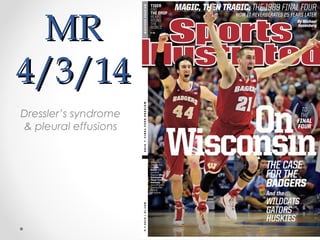
Mr 432014
- 1. MRMR 4/3/144/3/14 Dressler’s syndrome & pleural effusions
- 2. Dressler’s syndromeDressler’s syndrome • AKA postpericardiotomy syndrome (PPCS) • Fever and pleuropericardial disease days or months after cardiac injury i.e. combination of pleuritis and pericarditis • Pathogenesis: An immune response to damaged cardiac tissue immune complexes deposit onto the pleura, lungs, and pericardium, eliciting an inflammatory response • Timeline: typically 1+ week after myocardial injury • Sx: chest pain, pericardial rub, fever, leukocytosis, pulmonary infiltrates, pleural effusions • Tx: aspirin or other NSAIDs. Colchicine is sometimes given for primary prevention after cardiac surgery o Prednisone, HOWEVER, in patients s/p MI there is a greater incidence of ventricular aneurysm formation and free wall rupture
- 3. What else you should know about pleural effusionsWhat else you should know about pleural effusions Diagnosis Comment Common Causes Heart failure Most common cause of transudative effusion; diuresis can cause borderline exudative chemical characteristics Atelectasis Small effusion caused by negative transpleural pressure Hepatic hydrothorax Most are right-sided; occurs in 6%-12% of patients with end-stage liver disease and clinical ascites; can occur in the absence of ascites Hypoalbuminemia Small bilateral effusions with evidence of generalized anasarca, from decreased intravascular oncotic pressure Constrictive pericarditis Usually bilateral with normal heart size; 95% have jugular venous distention Trapped lung Unilateral as a result of remote pleural inflammation and resultant unexpandable lung; caused by negative transpleural pressure Uncommon Causes Cerebrospinal fluid leak into pleural space (duropleural fistula) Caused by trauma or thoracic spinal surgery Urinothorax Unilateral effusion caused by ipsilateral obstructive uropathy; the only low-pH transudate Iatrogenic Caused by a central venous catheter misdirected into the pleural space Superior vena cava obstruction From acute systemic venous hypertension or lymphatic congestion Peritoneal dialysis Massive effusion; develops within 48 hours of initiating dialysis due to dialysate crossing into the chest because of congenital or acquired defects • No thoracentesis if < 1 cm* • Gradients if transudative • TP > 3.1 g/dL OR Alb > 1.2 g/dL* • Exudative if • Pleural TP : Serum TP > 0.5 OR Pleural LDH > 2/3 ULN • > 10,000 WBC typically suggests infection • Uncomplicated parapneumonic: influx of PMNs and fluid that resolves with treatment • Complicated parapneumonic : bacterial invasion drain for faster recovery & less risk of complications • Empyema: Pus drainage • Other causes • Pancreatitis, PE, Subphrenic abscess, TB, rheumatoid, lupus pleuritis • Eosinophilia: meds, fungi, parasites, eosinophilic pneumonia, Churg-Strauss, benign asbestos pleural effusions * Not always
- 4. Pleural fluid quizPleural fluid quiz • Adenosine deaminase • Triglycerides • Magic cut-off for pleural triglyceride level • NT ProBNP • % of caner positive cells after first thoracentesis • % of caner positive cells after second thoracentesis • % of caner positive cells after third thoracentesis • Magic cut-off for pleural glucose • Magic cut-off for pleural pH *you don’t tend to see a low pH in uncomplicated effusions
- 5. Other things to considerOther things to consider • Erosion of a central venous catheter through venous structures into the pleural space pleural fluid accumulation and mediastinal widening (mediastinal hygroma) • Disruption of the thoracic duct or its intrathoracic lymphatic tributaries chylothorax • Infectious mediastinitis : usually bilateral effusions. Managed with debridement and irrigation
- 6. Other things to considerOther things to consider • Erosion of a central venous catheter through venous structures into the pleural space pleural fluid accumulation and mediastinal widening (mediastinal hygroma) • Disruption of the thoracic duct or its intrathoracic lymphatic tributaries chylothorax • Infectious mediastinitis : usually bilateral effusions. Managed with debridement and irrigation